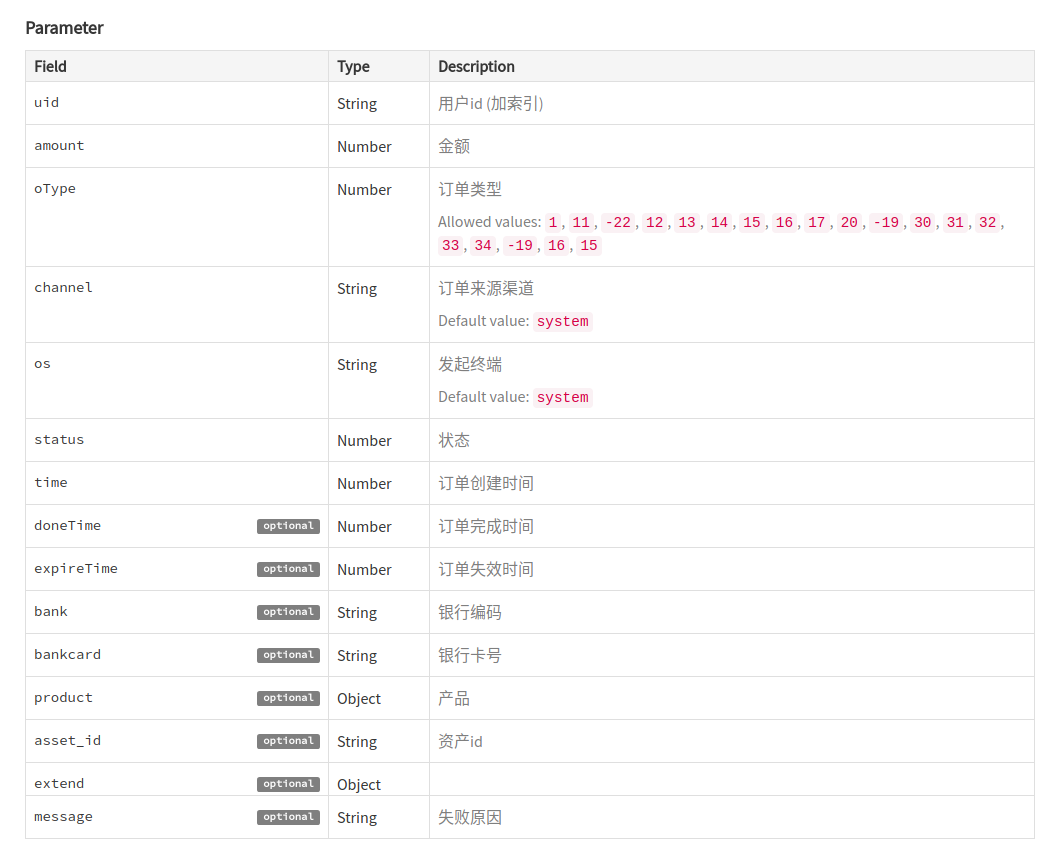公司在之前进行存管对接后,对内部架构进行了细分,业务逻辑也比之前复杂了不少,由此数据库文档的必要性显得十分重要;组长参照了mysql在定义字段时添加的comment字段生成文档,在mongoose也使用了这一方式,然后通过读取model.js生成符合apidoc的注释,通过apidoc生成文档。
- 先看效果:

Screenshot from 2017-09-17 23-43-58.png
说来惭愧,这任务本来是落在我身上,当时我根据apidoc的样式模拟写出html,但是显示效果不好,组长就想到利用apidoc来生成文档,但是我拖拉了两个周末后组长自己写了demo,而后我只是做了样式优化的部分
// 这是之前我写得第一版
const TYPES = [String, Date, Boolean, Number]
const field = User.schema.obj
// console.log(field.type.name, field.comment)
let tbody = ''
// 定义空格符
const space = ' '
function renderTbody(data, index) {
for (const attr in data) {
index = index || 0
// 如果是子属性,则添加空格符
let gap = ''
for (let i = 0; i < index; i++) {
gap += space
}
if (_.includes(TYPES, field[attr])) {
tbody += `
<tr>
<td class="code">${gap}${attr}</td>
<td>${typeof field[attr]()}</td>
<td><p>${attr}</p></td>
</tr>
`
} else if (attr.comment) {
tbody += `
<tr>
<td class="code">${gap}${attr}</td>
<td>${typeof field[attr].type()}</td>
<td><p>${field[attr].comment}</p></td>
</tr>
`
} else {
renderTbody(field[attr], index + 1)
}
}
}
renderTbody(field)
const body = `
<table class="table">
<thead>
<tr>
<th style="width: 30%">Field</th>
<th style="width: 10%">Type</th>
<th style="width: 40%">Description</th>
</tr>
</thead>
<tbody>
${tbody}
</tbody>
</table>
`
let html = `<!DOCTYPE html>
<html>
<head id="head">
<meta charset="UTF-8">
<meta name="format-detection" content="telephone=no">
<meta name="Description" content="modelDoc">
<title>modelDoc</title>
<link rel="stylesheet" type="text/css" href="./modelDoc.css">
</head>
<body>
<h3>${User.schema.name}</h3>
${body}
</body>
</html>`
console.log('生成页面...')
fs.writeFileSync(path.resolve(__dirname, '../../assets/modelDoc/index.html'), html)
process.exit(0)以下是apidoc的版本
- 先来看看model的定义
attributes: { uid: { type: String, required: true, index: true, comment: '用户id' }, amount: { type: Number, required: true, comment: '金额' }, oType: { type: Number, required: true, enum: Object.values(Constant.ORDER_TYPE), comment: '订单类型' }, channel: { type: String, required: true, default: Constant.CHANNEL.SYSTEM, comment: '订单来源渠道' }, os: { type: String, required: true, default: Constant.CLIENT.SYSTEM, comment: '发起终端' }, status: { type: Number, required: true, comment: '状态' }, time: { type: Number, required: true, comment: '订单创建时间' }, doneTime: { type: Number, comment: '订单完成时间' }, expireTime: { type: Number, comment: '订单失效时间' }, // 充值提现订单有 bank: { type: String, comment: '银行编码' }, bankcard: { type: String, comment: '银行卡号' }, // 购买还款订单有 product: { type: Object, comment: '产品' }, asset_id: { type: String, comment: '资产id' }, extend: { type: Object // 统计所有用到extend的地方,都加上 // isLazy: {type: Boolean, comment: '是否自动投资'} }, message: { type: String, comment: '失败原因' } } - model层使用了脚本读取文件
const fs = require('fs');
const path = require('path');
const models = fs.readdirSync(path.resolve(__dirname, './'));
let ret = {};
for (const model of models) {
ret[model.slice(0, model.indexOf('.js'))] = require(`./${model}`)
}
module.exports = ret;因此在读取model时只需要const models = require('../../app/model/')
- 先定义apidoc的name和group,然后通过generateFieldDoc函数生成相应的注释,最后将生成的注释写入指定的文件内
for (let i in models) { let model = models[i] const schema = model.schema.obj doc += ` /** * @api {POST} /${model.modelName} ${model.modelName} * @apiName ${model.modelName} * @apiGroup model ` for (let attr in schema) { doc += generateFieldDoc(attr, schema[attr]) } doc += ' */\n' } fs.writeFileSync(path.resolve(__dirname, '../../app/model/modelDoc.js'), doc) process.exit(0)
function generateFieldDoc (key, value) {
let prefix = ' * @apiParam'
let defaultStr = ''
let enumStr = ''
// 这里调用lodash的isFunction,兼容type: String这种写法
if (_.isFunction(value)) {
return `${prefix} {${value.name}} ${key}\n`
}
if (_.isObject(value) && value.type) {
let description = value.comment || ''
// apidoc没有索引标志,所以只能写在description
if (value.index) {
description += ' (加索引)'
}
// 只能规定的值
if (value.enum) {
// 区分number和string
if (value.type === Number){
enumStr += `=${value.enum.join(',')}`
} else if (value.type === String){
enumStr += `="${value.enum.join('\",\"')}"`
}
}
// 是否有默认值
if (value.default) {
defaultStr += value.type === String ? `="${value.default}"` : `=${value.default}`
}
// 是否必填
if (!value.required) {
if (value.enum) {
key = `[${key}`
enumStr = `${enumStr}]`
} else {
key = `[${key}]`
}
}
return `${prefix} {${value.type.name}${enumStr}} ${key}${defaultStr} ${description}\n`
}
const type = _.isArray(value) ? 'Array' : 'Object'
let ret = `${prefix} {${type}} ${key}\n`
// 若是数组,将递归执行generateFieldDoc
for (let attr in value) {
ret += generateFieldDoc(`${key}.${attr}`, value[attr])
}
return ret
}总结
总得来说,借助apidoc生成model文档,是可以满足查看的需求,而且显示上可以与接口文档存放在同一位置统一查看,不过在显示效果上可以缺失了索引等属性。